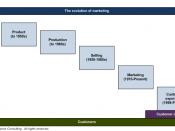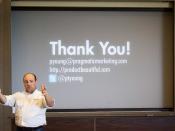1.Introduction
The following document is a response to the coursework assigned in MK207A: Marketing Essentials. It outlines and describes what different orientations (marketing management philosophies) companies can go through and why successful companies end up sticking to the marketing orientation.
1.1.Structure
This document will first describe what an orientation is and what major orientations exist. It will then examine the process that companies go through as they adhere to different orientations in their lifespan. Lastly the different orientations will be compared and it will be concluded why companies choose to follow a marketing orientation.
2.What is an orientation
Companies, whether large or small, exists because of the need or demand that they fulfill. They build products or provide services to make a profit and provide their customers with what they need in return(1). The difference between a company providing a product or service and a single person providing the same, is that a company's core purpose of the exchange just described is to generate a surplus whereas a single person might partake in an exchange because of many varied reasons(2).
Because companies' mission is invariable, and because many other companies exist that can or will provide the same service, companies need to continually improve the value that both they and their customers receive from an exchange. To do so, companies(3) continually revise how they do their business with their customers. They think about how and why they sell their products. A portion of these thoughts are classified as a marketing management philosophy or an orientation. As such, a marketing management philosophy is not something most companies adhere to; it is a way for us to describe how a company "achieves desired exchanges with target markets"(4), a mold that we use to fit live cases into laboratory cages.


